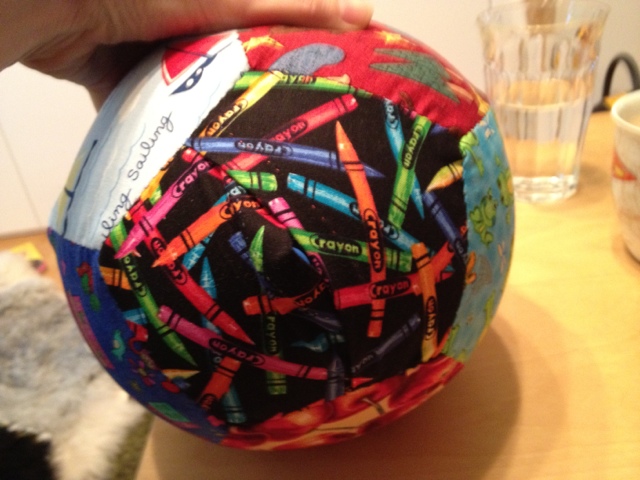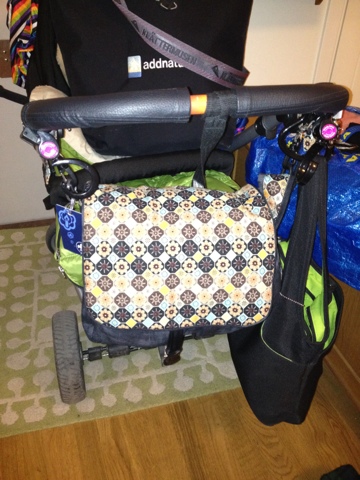Note: this is not an endorsement of using the carrier as we do. Follow all manufacturer's instructions and make your own judgement on how to keep your baby safe if undertaking any activities like these!
Why an Onya Baby?
My son (T) is now 15 months old, and he's outgrown the Baby Björn we used with him when he was younger. We also have a Babylonia Tricot Slen, which is a knitted baby wrap or shawl (a wraparound sling), a long piece of fabric with a slight stretch, that you wrap around yourself and use to carry the baby. I loved the shawl when he was smaller, and still use it occasionally if he's fretting and I want to hold him close for a while to soothe him. But I just can't figure out how to hoist him onto my back and then spread out the fabric over him for a safe back carry. We also have a Macpac Vamoose Child Carrier for serious walking, but I wanted something to put him in when he wants to be close and I want to get the housework done. So interneting I went...There are lots of soft structured baby carriers out there. I didn't want the hassle of a wrap or shawl, and the mei tais and similar combination wraps that I saw looked like the straps could get very uncomfortable quite quickly. I'm sure they are fine if you know what you're doing, but I wanted more structure in mine. I decided on the Onya Baby because it has a long back, and my baby's already 15 months old and tall for his age. Plus I'm quite tall, and my husband's even taller. The Onya comes in an "outdoors" type fabric, making it more showerproof if you're out in the weather. And, the Onya has the in-built portable highchair alternative, which was a very attractive feature to me. Plus I liked the look of it, and there was more chance of my husband being happy to wear this model than any of the others I saw. (Onya has a very handy comparison chart here.)
Onya isn't available here, so I ordered directly from the company in the US. After some personal contact to sort out some bumps in my payment, it came through in good time; ready for our holidays!
Initial impressions:
Like I said above, we own a few other baby carrying devices, but no other soft structured carriers. So this isn't a comparison to any other carrier; it's my own impressions compared with, well, nothing.The Onya is easy to put on, and easy to understand how to use. It comes with an instruction book, but you can easily figure it out from the videos on their website. I put it on and wriggled my son into it, and he was happy to be there (very different to his attitude to my faffing around with the shawl!).
The buckles are all strong and click well into position. The elastic safety loop on the waist belt is a pain to manoevre, and I wonder how well the elastic will last over time, but I don't have any suggestions for how it could be improved. It feels a bit odd to be tightening the shoulder straps upwards, when most backpacks I've ever used tighten downwards, but you get used to it quickly.
We tried out the carrier on me and my husband, and tried a few different ways of lifting in our son. We found that you have to make sure that he is really sitting deep in the back panel. If the panel is pulled too taut upwards, he sits lower in relation to the top of the carrier, he can't see out, and he doesn't like that. In general, he sits higher when I am wearing it, and is happier with that, than when my husband is wearing it. Maybe because my husband has a longer back and the panel is pulled higher and T sits lower in relation to looking over my husband's shoulder.
Our premier tour was to the local playground. T walked there and I wore the empty carrier. Then I lifted him in (easily, despite us both being novices) and we went up the hill to a friend's house on the way home. So far, so good!
One thing I did early on was to sew a storage/travel bag for the carrier. A soft structured baby carrier is an awkward thing to transport or pack, with long trailing straps and buckles. It would be great if the carrier came with a matching, right size storage bag.
Off on holiday:
The big test was a holiday we had planned in northern Sweden. Sweden is very child friendly, but not every cafe and restaurant has highchairs. And we wanted to do some walking. We were flying there and hiring a car. With gear for four adults and one toddler, and one car to fit everything in, we decided to leave our rigid child back carrier at home and only take the Onya Baby.It worked wonderfully! My husband and I alternated and we both wore the carrier at different times. Having this carrier with us, we were able to do things that just wouldn't have been safe without a carrier, and wouldn't have been possible with a child carrier. Things like riding in a ski chairlift for 20 minutes up the mountain. T was strapped into the Onya on my husband's front, and he rode there safe and secure all the way up. Once there, we put the Onya on a chair in the cafe for him to sit in. (They obviously do not get many highchair riding children in the Panorama restaurant that it takes a chairlift or a hike of several hours to reach...).
We went to the Ice Hotel and saw the 'ruins' of this year's hotel. We did a tour of the production and ice storage areas, T safe (and warm) in the Onya carrier.
We also went walking in Abisko National Park one day, following the first part of the "King's Trail" ("Kungsleden"). We were out for more than four hours. T rode in the carrier for a lot of that time. Where the trail was safe he walked for a bit. When we were near the river or any steep drop-off, he was safe on one of our backs. He could look around and reach for overhanging leaves. After lunch, when it all got a bit exhausting, he dropped off and had quite a reasonable nap in the Onya, with the hood up to support his head. It got quite warm that day, but he was fine and we could lift him down and let him stretch his legs and feel the breeze whenever he needed to.
Other thoughts about the carrier:
I love that the Onya Baby has pockets to tuck some small things into. I can carry my phone, purse and keys, a mini sunscreen and hand disinfectant, and still have room for one or two other things. It doesn't feel like these items are making the carrier uncomfortable, but you do need to think not to stuff the pocket too full. My son is, after all, still too small to tell me if my keys are stabbing him.We have found that the straps twist through the buckles quite often. If you don't make sure that the strap is not twisted and then pull it through straight, it's easy to slide through a twist and then it's a bit fiddly to get it right again. Fiddly, but not a huge problem. Maybe it would be possible to fix this if the buckle holes were a little narrower.
We haven't tried using the hood in the rain, with my son awake. I suspect it won't stay on for long. But if we're going to be out in the rain, he'll have a raincoat and hood on anyway, and the carrier hood should work well for smaller children.
All in all, this was one internet shopping gamble that paid off for us. We are really happy with the Onya, and I anticipate that it will be getting lots of use, home and outdoors, in the coming months.
Here are some things you can do with an Onya Baby carrier:
You can look at the ruins of the Ice Hotel, go on a tour of their production
and storage areas, and see the indoor Ice Hotel and Ice Bar.
You can ride a chairlift up a mountain at midnight, to try and see the midnight sun through the clouds.
Safe and warm on pappa's chest, high over the mountain.
You can sit in the Abisko Njulla Panorama restaurant having a midnight snack,
and enjoying the fire while it tries to snow outside (at Midsummer!)
You can go hiking on the King's Trail.
You can look at the river, rushing with snow melt from the mountains.
You can jump down easily and walk some of the trail yourself.
And take a nap when it all gets a bit exhausting.
And you can visit wonderful places like this on Torneträsk (lake),
carried safely down the steep path, to a treasure beach full of stones!




























































